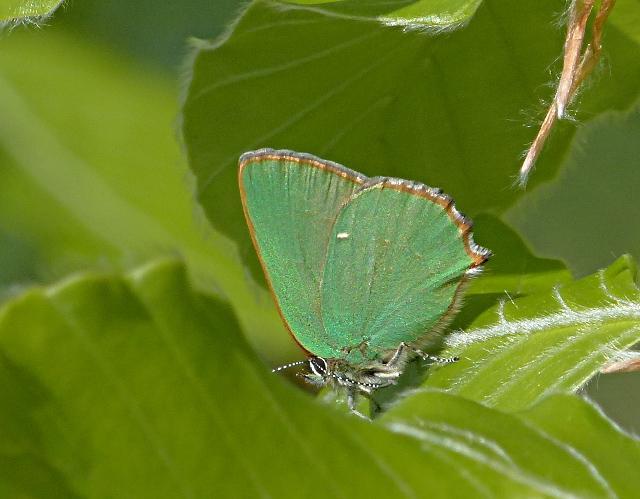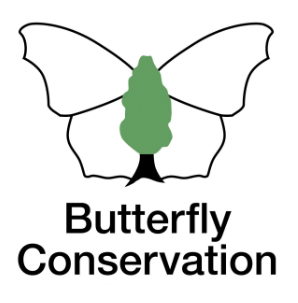Brown Argus
Brown Hairstreak
Chalkhill Blue
Clouded Yellow
Comma
Common Blue
Dark Green Fritillary
Dingy Skipper
Essex Skipper
Gatekeeper
Green Hairstreak
Green-veined White
Grizzled Skipper
Holly Blue
Large Skipper
Large White
Marbled White
Meadow Brown
Orange-tip
Painted Lady
Peacock
Purple Emperor
Purple Hairstreak
Red Admiral
Ringlet
Silver-washed Fritillary
Small Blue
Small Copper
Small Heath
Small Skipper
Small Tortoiseshell
Small White
Speckled Wood
Wall
White Admiral
White-letter Hairstreak
Extinct/rare immigrants
Green Hairstreak
Callophrys rubi
General Distribution and Status
This is our most widespread hairstreak where it can be found throughout Britain but colonies are discrete and usually small. During the 20th century numerous colonies were destroyed through agricultural improvement, ploughing up of grasslands and intensive forestry (Heath et al.). Even since 1976 colonies are still being lost due to habitat destruction; both range and distribution have been reduced by about a third (Fox et al.). However, because the butterfly can be found in a variety of habitats it is unlikely to become endangered. A similar story in Hertfordshire and Middlesex where it can be found at Hexton Chalk Pit, Aldbury Nowers, Tring Park and Telegraph Hill, all on calcareous grassland although it has recently been seen away from the chalk such as in Middlesex like Tower Hamlets Cemetery Park, Trent Park and Kempton Nature Reserve indicating perhaps a small increase in range. It does not appear to exist in open areas in woodland in the branch area like it did in the past.
| United Kingdom | Herts & Middx | |||
| Distribution | 1976-2019 | -16% | 1980-2015 | -39% |
| Average 10-year trend | -4% | 2006-2015 | +53% | |
| 2024 since 2015-19 | +50% | |||
| Abundance | 1976-2024 | -34% | 1980-2015 | -69% |
| 2015-2024 | +6% | 2006-2015 | +98% | |
| 2023-2024 | +14% | 2024 since 2015-19 | -50% | |
UK distribution map
UKBMS Species summary
Habitat Requirements
A variety of habitats suit this butterfly including unimproved grassland, railway banks, and woodland rides but scrubby plants or hedgerows must be present.
Larval Foodplants
Common Rock-rose Helianthemum nummularium, Broom Cytisus scoparius, Dyer's Greenweed Genista tinctoria, Gorse Ulex spp., Common Bird's-foot Trefoil Lotus corniculatus on chalk, Bilberry Vaccinium myrtillus on moorland. Other foodplants used include Greater Bird's-foot Trefoil L. pedunculatus, Dogwood Cornus sanguinea, Buckthorn Rhamnus catharticus and Bramble Rubus fruticosus (Sawford 1987). Females have a strong preference for Dyer's Greenweed G. tinctoria where they have the choice (Thomas & Lewington).
Adult Food Sources
Goat Willow Salix cinerea (80), Bluebell Hyacinthoides non-scripta (24), Common Bird's-foot Trefoil Lotus corniculatus (12). Hawkweed Hieracium sp. and Hawthorn Crataegus monogyna are other nectar sources (Newland et al.).
Historical Records
Although Gibbs (1902) describes it 'as unusually abundant about the beech woods ..' in the county he did not mention any records for the Stevenage area, although Matthews had reported it at Norton Green Woods around this time (Tutt). Collections at the Hitchin Natural History Museum hold examples of Green Hairstreak captured at Graveley in 1918. Ray Palmer found specimens on 21 May 1922, 1 May 1923 and 19 May 1923 in Knebworth woods. Foster (1934) refers to it as 'still abundant near Graveley'. In 1945, one was caught by a bank in Stevenage (TL22H) but no other details given (Sawford, cards). Roger Ferry in his diaries reports that this species was seen at Newton Wood but no date was given although it was probably in the 1940s. He also notes that M. Quinn reported that M. Bennett captured a number of specimens on 20 April 1946 but unfortunately the locality was not stated.
Local Distribution and Abundance
Only one record of the butterfly was reported since 1995. Brian Sawford saw 2 specimens at Crouch Green on 1 May 1997.

Life History
Only one generation is produced each year with most specimens emerging in May and early June. Eggs are laid singly on the foodplant and hatch after about ten days.
Larvae begin by feeding in buds then the leaves as they grow. Pupae are formed on the ground, often in ants' nests. The ants being attracted by the pupae are
thought to carry them to the nests. The winter is spent in the pupal stage.
More details on the UK Butterflies website
Behaviour/Observation notes
Males take up territories around shrubs like hawthorn, in search for females or to chase off rival males. Females tend to fly close to the ground.
Variations/Aberrations
Variations are mostly on the extent of the white spots on the undersides. One interesting aberration found in Buckinghamshire in
2011 had the white spots on the hindwings much enlarged, tending to radiate towards the outer margins, ab. radiata (Campbell).
Find out more on the UK Butterflies website
References

Bison Hill 13 May 2015



